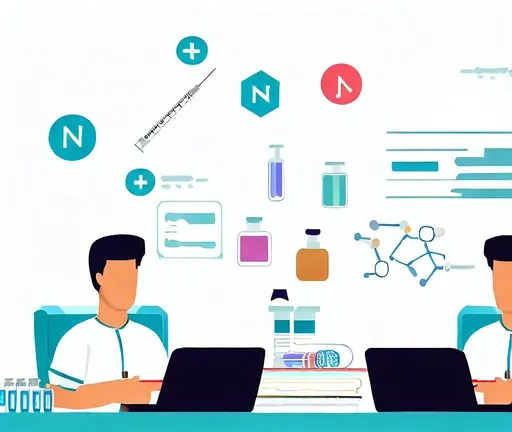Understanding Drug Interactions: A Guide for Nursing Students

The Significance of Drug Interactions
The significance of understanding drug interactions in healthcare cannot be overstated. These interactions occur when various substances, including medications and even certain foods, impact each other's effects once they enter the body. These interactions can result in a range of outcomes, from boosting the therapeutic benefits of a drug to diminishing or altering its intended effects. This variability in drug interactions means that without proper management, patients could experience unexpected and potentially harmful consequences.

For nursing students, recognizing the significance of drug interactions is crucial. It highlights the need for them to be vigilant in identifying potential interactions and understanding their implications. By doing so, nursing professionals can contribute significantly to patient safety and ensure that treatment outcomes are as effective as possible. Ultimately, this knowledge is a cornerstone of responsible and effective patient care in the healthcare field.
Types of Drug Interactions
Understanding the different types of drug interactions is crucial for nursing students as it allows them to anticipate and manage potential complications in patient care. Here's a brief explication of the mentioned types:
- Pharmacokinetic Interactions: These interactions involve alterations in how drugs are absorbed, distributed, metabolized, or excreted in the body. Enzyme induction or inhibition can play a significant role in these interactions. For example, if one drug inhibits the enzymes responsible for breaking down another drug, it can lead to higher-than-expected levels of the drug in the body, potentially causing adverse effects or toxicity. Conversely, enzyme induction can accelerate drug metabolism, reducing its effectiveness.
- Pharmacodynamic Interactions: This type of interaction focuses on how drugs influence each other's actions at the target site or receptor. In such cases, one drug can either enhance or diminish the effects of another, leading to outcomes that may not have been anticipated. Nursing students must be aware of these interactions as they can impact treatment effectiveness and patient safety.
- Combined Toxicity: Sometimes, when two or more drugs are used in combination, they can produce toxic effects that wouldn't occur if each drug were used individually. This emphasizes the need for careful monitoring of patients, as seemingly safe medications can become harmful when used together. Nursing professionals must be vigilant in recognizing signs of combined toxicity to ensure patient well-being.
Comprehending these types of drug interactions equips nursing students with the knowledge needed to anticipate, identify, and manage potential complications in medication administration. It underscores the importance of thorough patient assessment, medication reconciliation, and ongoing monitoring to provide safe and effective care.
Mechanisms of Drug Interactions
The mechanisms of drug interactions delve into the intricate ways in which medications can interact within the body, often yielding unexpected or altered effects. Understanding these mechanisms is essential for healthcare professionals, including nursing students, as it empowers them to anticipate and mitigate potential complications in patient care. These mechanisms encompass factors like enzyme interactions, protein binding, and synergistic or antagonistic effects, all of which play pivotal roles in shaping how drugs interact within the human body.
- Enzyme Inhibition and Induction: Many drugs are metabolized by specific enzymes in the liver. Enzyme inhibitors can slow down the metabolism of other drugs, leading to increased concentrations and potential toxicity. On the other hand, enzyme inducers can speed up the metabolism, reducing the effectiveness of certain drugs.
- Protein Binding: Some drugs bind to proteins in the bloodstream. When two drugs compete for the same binding sites, one drug's efficacy might be compromised. This can lead to a need for dose adjustments to achieve the desired therapeutic effect.
- Synergistic and Antagonistic Effects: Drug interactions can result in synergistic effects (enhancing the effect) or antagonistic effects (reducing the effect). Nursing students should understand how these interactions can impact patient responses to treatment.
Managing Drug Interactions
Managing drug interactions is a critical aspect of healthcare, aimed at preventing adverse effects and ensuring the efficacy of medications. It encompasses a range of strategies and practices used by healthcare professionals to assess, prevent, and mitigate potential interactions between different drugs or substances a patient may be taking. Understanding and implementing effective management techniques is essential for safeguarding patient safety and optimizing treatment outcomes.
- Comprehensive Medication Review: Before administering any medication, nursing students should conduct a thorough review of the patient's current medication regimen. This helps identify potential interactions and allows healthcare providers to make informed decisions.
- Communication and Collaboration: Effective communication among healthcare professionals is vital. Nurses should work closely with pharmacists and physicians to assess potential drug interactions, especially in complex cases.
- Patient Education: Nursing professionals play a crucial role in educating patients about their medications. Patients need to be aware of potential interactions, including interactions with over-the-counter drugs, herbal supplements, and dietary restrictions.
- Regular Monitoring: Monitoring patients for signs of adverse effects or unexpected outcomes is essential. This can involve observing changes in vital signs, laboratory values, and the patient's overall condition.
Real-world Examples
Real-world examples of drug interactions illustrate the practical relevance of understanding how various medications and substances can interact within the human body. These examples highlight instances where drug interactions have had significant consequences, underscoring the importance of vigilance in healthcare practice. By examining these cases, healthcare professionals, including nursing students, can gain valuable insights into the potential risks and complexities associated with drug interactions, ultimately enhancing patient care and safety.
- Warfarin and Antibiotics: Antibiotics like ciprofloxacin can interfere with the metabolism of warfarin, a commonly prescribed blood thinner. This interaction can lead to an increased risk of bleeding. Nursing students need to recognize such interactions and collaborate with the healthcare team to adjust medication regimens accordingly.
- Grapefruit Juice and Statins: Grapefruit juice can inhibit the enzyme responsible for metabolizing statin medications. This can result in elevated statin levels, increasing the risk of adverse effects such as muscle pain and liver damage. Nursing students should educate patients about avoiding grapefruit products while taking statins.
Conclusion
In the realm of healthcare, the significance of understanding drug interactions cannot be overstated. Nursing students must grasp the intricacies of how drugs interact within the body to ensure patient safety and promote optimal therapeutic outcomes. By recognizing the different types and mechanisms of drug interactions, nursing professionals can effectively manage medications, communicate with other healthcare providers, educate patients, and provide vigilant monitoring. As the healthcare landscape evolves, nursing students armed with advanced pharmacological knowledge will undoubtedly play a pivotal role in improving patient care and well-being.